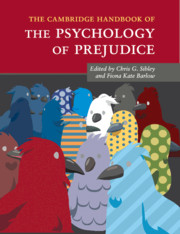Book contents
- Frontmatter
- Dedication
- Contents
- List of Figures
- List of Tables
- Notes on the Contributors
- Part I General Theoretical Perspectives
- Part II Prejudice in Specific Domains
- 11 Understanding the Nature, Measurement, and Utility of Implicit Intergroup Biases
- 12 Aversive Racism and Contemporary Bias
- 13 Ambivalent Sexism in the Twenty-First Century
- 14 Sexism in Intimate Contexts: How Romantic Relationships Help Explain the Origins, Functions, and Consequences of Sexist Attitudes
- 15 Religion and Prejudice
- 16 Sexual Prejudice: Advances in Conceptual and Empirical Models
- 17 Weight Bias: Prejudice and Discrimination toward Overweight and Obese People
- 18 Prejudice Against Immigrants in Multicultural Societies
- 19 Generalized Prejudice: Old Wisdom and New Perspectives
- Part III Prejudice Reduction and Analysis in Applied Contexts
- Index
- References
12 - Aversive Racism and Contemporary Bias
from Part II - Prejudice in Specific Domains
Published online by Cambridge University Press: 17 November 2016
- Frontmatter
- Dedication
- Contents
- List of Figures
- List of Tables
- Notes on the Contributors
- Part I General Theoretical Perspectives
- Part II Prejudice in Specific Domains
- 11 Understanding the Nature, Measurement, and Utility of Implicit Intergroup Biases
- 12 Aversive Racism and Contemporary Bias
- 13 Ambivalent Sexism in the Twenty-First Century
- 14 Sexism in Intimate Contexts: How Romantic Relationships Help Explain the Origins, Functions, and Consequences of Sexist Attitudes
- 15 Religion and Prejudice
- 16 Sexual Prejudice: Advances in Conceptual and Empirical Models
- 17 Weight Bias: Prejudice and Discrimination toward Overweight and Obese People
- 18 Prejudice Against Immigrants in Multicultural Societies
- 19 Generalized Prejudice: Old Wisdom and New Perspectives
- Part III Prejudice Reduction and Analysis in Applied Contexts
- Index
- References
Summary
In the United States, the 1960s and early 1970s were characterized by significant societal changes. The Civil Rights Movement and social, political, and moral forces stimulated these changes to address racism by White Americans toward Black Americans and achieve the nation's historical egalitarian ideals. With the Civil Rights legislation and other federal mandates, it was no longer simply immoral to discriminate against Blacks; it was now also illegal. Surveys and national polls revealed significant reductions in overt expressions of prejudice among Whites toward Blacks (Dovidio & Gartner, 2004). This unprecedented change in race relations in the United States changed the nature of racial attitudes, from blatant to subtle, and consequently the study of prejudice in psychology (Dovidio, 2001). In other countries, similar normative changes have reduced blatant expressions of prejudice while more subtle, yet equally pernicious, forms of bias persist (see Pettigrew & Meertens, 1995).
This chapter reviews the development of theory about contemporary forms of racism – focusing primarily on aversive racism – tracing the evolution of this perspective, describing key empirical evidence, and identifying productive avenues for future research. We begin by reviewing relations among different theories of subtle contemporary racism and discussing work on implicit prejudice and its relationship to aversive racism. We then consider the implications of aversive racism for interventions to reduce bias and identify promising new directions for research on contemporary racism, in general, and aversive racism, in particular.
Overview of Theories of Subtle Racism
The changing social norms and values shaped by the civil rights era posed unique challenges to the study of prejudice. Although overt expressions of prejudice and negative stereotyping have substantially declined, in part because of new normative pressures toward egalitarianism, privately held beliefs continue to reflect negative racial attitudes and beliefs. One effect of these new norms was that people appeared to more deliberately manage how others perceived their racial attitudes. For example, when expressing attitudes under conditions in which they were led to believe their true attitudes could be detected (e.g., bogus pipeline; Roese & Jamieson, 1993), Whites displayed significantly more negative attitudes toward Blacks than when they reported their attitudes under more normal conditions. This effect occurred, in part, because people normally consciously manage self-reports of prejudice and interracial behaviors to appear nonbiased.
- Type
- Chapter
- Information
- The Cambridge Handbook of the Psychology of Prejudice , pp. 267 - 294Publisher: Cambridge University PressPrint publication year: 2016
References
- 58
- Cited by



